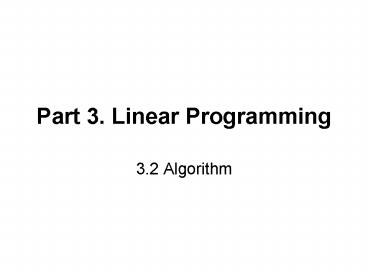Part 3. Linear Programming - PowerPoint PPT Presentation
1 / 38
Title:
Part 3. Linear Programming
Description:
Part 3. Linear Programming 3.2 Algorithm General Formulation Example Graphical Solution Degenerate Problems Degenerate Problems No feasible region Simplex Method ... – PowerPoint PPT presentation
Number of Views:201
Avg rating:3.0/5.0
Title: Part 3. Linear Programming
1
Part 3. Linear Programming
- 3.2 Algorithm
2
General Formulation
Convex function
Convex region
3
Example
4
Profit
Amount of product p
Amount of crude c
5
Graphical Solution
6
Degenerate Problems
Non-unique solutions
Unbounded minimum
7
Degenerate Problems No feasible region
8
Simplex Method The standard form
9
Simplex Method - Handling inequalities
10
Simplex Method - Handling unrestricted variables
11
Simplex Method- Calculation procedure
12
Calculation Procedure- Step 0
13
Calculation Procedure - Step 1
14
Calculation ProcedureStep 2 find a basic
solution corresponding to a corner of the
feasible region.
15
Remarks
- The solution obtained from a cannonical system by
setting the non-basic variables to zero is called
a basic solution (particular solution). - A basic feasible solution is a basic solution in
which the values of the basic variables are
nonnegative. - Every corner point of the feasible region
corresponds to a basic feasible solution of the
constraint equations. Thus, the optimum solution
is a basic feasible solution.
16
Full Rank Assumption
17
(No Transcript)
18
Fundamental Theorem of Linear Programming
- Given a linear program in standard form where A
is an mxn matrix of rank m. - If there is a feasible solution, there is a basic
feasible solution - If there is an optimal solution, there is an
optimal basic feasible solution.
19
Implication of Fundamental Theorem
20
Extreme Point
21
Theorem (Equivalence of extreme points and basic
solutions)
22
Corollary
- If there is a finite optimal solution to a linear
programming problem, there is a finite optimal
solution which is an extreme point of the
constraint set.
23
Step 2
x1 and x2 are selected as non-basic variables
24
Step 3 select new basic and non-basic variables
new basic variable
25
Which one of x3, x4, x5 should be selected as the
new non-basic variables?
26
Step 4 Transformation of the Equations
27
0
28
Repeat step 4 by Gauss-Jordan elimination
29
N
N
B
B
B
Step 3 Pivot Row Select the smallest positive
ratio
bi/ai1
Step 3 Pivot Column Select the largest positive
element in the objective function.
Pivot element
30
Basic variables
31
Step 5 Repeat Iteration
An increase in x4 or x5 does not reduce f
32
(No Transcript)
33
It is necessary to obtain a first feasible
solution!
Infeasible!
34
Phase I Phase II Algorithm
- Phase I generate an initial basic feasible
solution - Phase II generate the optimal basic feasible
solution.
35
Phase-I Procedure
- Step 0 and Step 1 are the same as before.
- Step 2 Augment the set of equations by one
artificial variable for each equation to get a
new standard form.
36
New Basic Variables
37
New Objective Function
If the minimum of this objective function is
reached, then all the artificial variables should
be reduced to 0.
38
Step 3 Step 5































